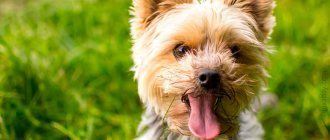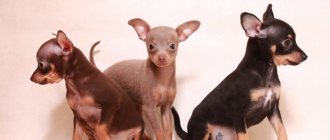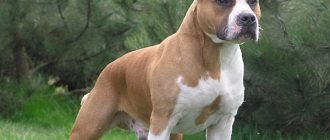Caring for an American Staffordshire Terrier is not particularly difficult. However, as is the case with other breeds, the owner must pay special attention to the pet’s diet, since proper and healthy nutrition is the key to the pet’s longevity.
A staff's diet should consist of a high percentage of meat.
Feeding
To feed the Amstaff, you need to use high quality products, marked for “large dogs”. It should have an attractive aroma and arouse the appetite of a picky pet. A serving is 1350 kilocalories per 20 kg of animal weight.
During physical activity, the serving size should be increased by 12-15%. The composition should include different ingredients: rice, poultry, animal fats, and there should be a source of lutein.
It is allowed to contain wheat and corn flour, barley, fructooligosaccharides, fish oil, and beet pulp in the feed. It is better to buy a product with a protein content of 35% and its high digestibility, the amount of fat is 30%, minerals up to 7%, BEV 40%, fiber 2%.
The food should contain vitamins: A, D, E, iron, iodine, manganese and zinc. The food will protect your pet's teeth and cleanse bacterial plaque.
Acana Adult Dog Heritag 17 kg
Holistic class food without grains, allergic substances. Contains different types of meat, fish - 55%. It contains eggs, medicinal herbs, vegetables, fruits, fermentation products, vitamin and mineral supplements. Does not contain GMOs.
pros
- Suitable for any dogs;
- It has useful composition and properties;
- Natural ingredients;
- Rich in fiber;
- Has good taste;
- Has a low glycemic index;
- Economical.
- When eating, there are no problems with the skin, vision, joints, or gastrointestinal tract.
Minuses
- Sold in large packages;
- Not all stores have it.
- Contains legumes, which increases gas formation.
Prohibited Products
Prohibited food for Amstaff:
- legume;
- boiled potatoes;
- pearl barley;
- unground oatmeal;
- spices;
- sausage;
- smoked products;
- tubular bones;
- “products from the family table.”
Inexperienced breeders want to pamper their pet by treating it with food from the table or scraps. This harms the Staffordshire Terrier, and does not benefit, as many people think. For example, bones can provoke constipation in a dog.
Go Fit + Free salmon, duck, turkey, chicken 2.72 kg
Holistic food without gluten. It contains more than 70% meat: turkey, chicken, duck, salmon fillet. Does not cause allergies. It is universal and designed for dogs of all breeds and ages.
pros
- Does not cause an allergic reaction;
- Natural ingredients;
- Enriched with nutrients, microelements, vitamins, oils, lactobacilli;
- Available in different packages;
- The package indicates the daily intake;
- Optimal ratio of price and quality;
- Does not contain by-products;
Minuses
- Poorly stored;
- When opened, it becomes weathered and loses its beneficial substances and properties. For long-term storage, pour into a closed container;
- Metabolism and the release of digestive products are enhanced.
- Increases fecal mass.
Orijen Adult Dog Freeze-dried food 0.45 kg
Belongs to the super premium class. Freeze-dried food, it can be given to dogs of all ages and breeds. Contains 80% meat and fish. The remaining percentages: eggs, legumes, liver, fruits, vegetables, herbs, microelements, lactobacilli. Does not contain preservatives, dyes, flavors, GMOs. Produced fresh, without freezing ingredients.
pros
- Balanced and natural composition;
- Does not contain grains;
- Does not cause allergies;
- Contains fiber;
- Improves appetite, digestion;
- It is used economically.
- They are produced using a technology where, due to exposure to low temperatures, only moisture is removed from the ingredients of the composition. All nutrients and beneficial substances are preserved.
- When consumed as food, the appearance and health of pets improves.
Minuses
- Increases feces and their output;
- Increases gas production in dogs;
- Not available in all stores;
- Sometimes rancid and burnt pellets with a bad odor are encountered.
Pro Plan Veterinary Diets Dermatosis 12 kg
Premium class dietary food. Used when the dog shows intolerance to something. This is often manifested by hair loss, areas of dermatitis, and digestive disorders. It contains fish extract, flour, beet pulp, potatoes, vitamins, and minerals.
pros
- Medicinal food;
- Does not contain allergens;
- Contains natural fiber;
- Suitable for pets who are intolerant to beef or chicken;
- Improves the health and appearance of dogs;
- Does not contain preservatives, dyes, flavors;
- Convenient packaging for storage and use;
- Medicinal food that should be given to dogs with hypersensitivity to allergens.
Minuses
- Strong fishy smell;
- Do not use if the dog has hypersensitivity to fish and potatoes;
- Animals experience an increase in thirst;
- Overcharge.
- If your dog has recovered, then you need to switch it to another food and monitor its health.
Ban commands
When a pit bull repeatedly violates discipline and shows disobedience - jumps on people with dirty paws, does not stop barking at passers-by, runs after sparrows and cats, tries to climb on upholstered furniture - they try to distract the pet to play together. If attempts are unsuccessful, they resort to prohibition commands. The most common is “Ugh!”
At the initial stage of training, together with the prohibiting command, they give a light slap with the palm of their hand or hit with a twig. There's no point in trying. Deafening shouts and severe beatings (which bring pain) will frighten the puppy, and if repeated many times, they will upset the mutual understanding between the animal and the person.
Barking Heads with lamb and rice Dreams of lamb 12kg
The food belongs to the premium class. Contains organic lamb meat, which was raised on natural products, vegetables, and medicinal herbs. Veterinarians recommend food for small and medium breeds. Ingredients: freeze-dried lamb meat - 20%, fresh meat - 30%, oats, rice, trout, potatoes, animal fats, a mixture of medicinal herbs, algae, vitamins, minerals.
pros
- Made from natural ingredients;
- Hypoallergenic;
- Improves the condition of the skin, coat and joints;
- Strengthens the immune system.
- It has a good taste and smell.
- Suitable for pets with sensitivity to allergens.
eFeeding the baby from 2 months
amstaff puppies
When composing your pet’s diet, you should adhere to the following rules:
- the puppy’s diet should contain at least 30% proteins, the lack of which can weaken the immune system and negatively affect the development of muscles and skeleton;
- Meat products alone are not complete nutrition;
- an overdose of calcium and vitamins A and D can lead to abnormalities of the skeletal system and contribute to the occurrence of diseases;
- you cannot feed the puppy without following the regime;
- overfeeding is harmful for both puppies and adult dogs.
You need to feed your puppy at certain intervals:
from 1.5 to 3 months – 5-4 times a day;
from 3 to 6 months – 3-4 times a day;
after 6 months – 2 times a day.
Considering that our puppies go to new families, having been raised on natural products, we hope that following the baby’s usual routine in the first weeks of his stay in the new home will help him adapt to the new family faster.
When creating a menu, it is considered ideal if the diet contains at least 3 sources of protein.
For the nutrition of puppies born and raised with us, we recommend the following products if the owner is willing to adhere to natural feeding.
- raw beef and beef by-products,
- lamb and lamb by-products,
-beef or lamb tripe, unpeeled, raw (can be used daily),
-meat of chickens, turkey, quails, as well as all offal - liver, heart, neck, stomach (unpeeled, together with the yellow film must be given raw!),
-chicken or quail egg.
- natural cottage cheese (not to be confused with a cottage cheese product!). Fat content 5-9%.
Sometimes a puppy does not like cottage cheese, and it is perfectly replaced by Adygei, Suzdal, or analogues of young, unsalted cheese.
- kefir, or any fermented milk products 2.5%-4% fat (I use kefir grains to ferment milk)
- any sea fish without small bones (herring, capelin, hake, pollock, mackerel, pink salmon)
- seasonal vegetables and fruits, without exotic ones, in reasonable quantities.
In the example below is a list of vegetables and fruits from the diet of some of our graduates.
Menu option for a puppy 2-3 months old :
6.00-7.00: cottage cheese 100 g + 2 quail eggs with shell. For dessert, you can offer a beef bone after the cottage cheese.
10.00-11.00: raw beef cut into large pieces with veins and fascia (size about 1.5 matchboxes) (or chicken gizzards, turkey stomach, whole, or chicken breast with breast cartilage, or unpeeled tripe in pieces) + coarsely chopped raw cabbage , carrots or zucchini. For dessert, you can give a quarter of an apple. About 50 grams of quail legs.
15.00-16.00: Raw, unpeeled tripe (beef or lamb). For dessert, you can give a raw chicken wing (or 2 necks without skin), or a beef joint bone.
21.00-22.00: raw poultry liver, heart, chicken wing + 1/4 cup of kefir or fermented baked milk (this can be left overnight if the baby has not finished drinking).
3)dried kelp thallus.
Menu option for a puppy 3 - 4 months old.
8.00 Lamb tripe 100 g, chicken heart (or beef, lamb) - 50 g, chicken back - 100 g. For dessert, half an apple.
13.00 beef pulp (lamb, turkey) - 200g, chicken heads 2 pieces, quail legs. Lettuce leaf for dessert.
19.00 soup set turkey 150 g, lamb heart 50 g, chicken scallops 3 pieces.
22.00 kefir + 2 quail eggs in shell.
Menu option for a puppy 3-4 months old. :
8.00 - minced lamb meat about 100g, 2 day old chickens, beef bone for dessert.
15.00 - beef 100g, lamb tripe 100g, quail legs, apple.
21.00 - pieces of rabbit meat, quail legs, chicken stomachs.
Source
Arden Grange Sensetiv Ocean White Fish and Potatoes 12kg
The food belongs to the super premium category. Contains the necessary natural ingredients for dogs: pieces of meat, fish oil. When consumed, dogs' endurance increases.
pros
- Has a rich vitamin and mineral complex;
- Does not contain GMOs, preservatives, artificial colors, flavors;
- Does not cause allergies;
- Does not contain cereals;
- Added antioxidants;
- The label shows the feeding schedule;
- Economically used;
- Has a good smell and taste;
- Improves pet's health.
- With long-term use there is no addiction to the composition;
- Suitable for dogs with a sedentary lifestyle and those in old age.
Minuses
- Some of its types contain corn, and this ingredient should not be in the super premium class.
Premium food that contains chicken, eggs, peas, potatoes, animals, vegetable fats, vegetables, and herbs in a balanced combination. Has a low glycemic index.
pros
- Does not contain grains;
- Does not cause allergies;
- Balanced composition;
- Natural ingredients;
- The product is suitable for a balanced diet so that there are no problems with the health, activity and appearance of the dog;
- Veterinarians recommend this brand as a dietary one;
- It has a good appearance, smell and taste.
Minuses
- Not available in all stores.
BARF system for staff
The BARF diet is based on foods that Staffies would presumably eat in the wild. It includes:
- raw meat;
- various bird bones, except rib and tubular bones, soft lamb bones;
- offal;
- sea fish;
- raw vegetables, herbs, berries and fruits;
- dairy products;
- eggs.
BARF diet
In addition, various vegetable oils, fish oil, vitamins, and bran are added to the staff’s diet. Owners and staff of veterinary clinics note the huge advantage of such nutrition for dogs of any kind.
How and what to feed your pet is always decided by the owner himself. It is important that this is a complete diet that will not cause allergies, so this issue must be approached responsibly.
Proseries Holistic with lamb and rice 12.9 kg
Holistic class food. It has a composition suitable for feeding dogs of all ages and breeds. It does not contain ingredients that help cause allergies: soy, corn, wheat, chicken. Instead of meat, they included fish, animals, and vegetable fats, which are well absorbed by the pet’s body.
pros
- Hypoallergenic;
- Balanced composition of natural ingredients;
- Strengthens the immune system, supports the animal’s musculoskeletal system;
- Improves blood circulation and appearance of the pet;
- Serves as a source of protein for dogs suffering from an allergic reaction to meat products;
- It passed all tests in America and Canada and, according to their results, it was recognized as a complete, balanced product to ensure the health of dogs at any age;
- The composition of the product is selected to pay maximum attention to the health of the dog.
Minuses
- Difficult to find in pet stores;
- Strong fishy odor;
- Contains grains.
Royal Canin medium adult 15 kg
Super premium food, created for a dog’s balanced nutrition and all its taste needs. Its composition: cereal flour, dehydrated pork, rice, fats of vegetable and animal origin, yeast. A vitamin and mineral complex has been added to the product.
pros
- Widely distributed throughout the Russian Federation;
- Has good taste;
- Well digested by the body;
- When consumed, the immune system is strengthened and the appearance of the skin and coat improves;
- The product has medicinal properties.
Grandorf Duck with sweet potato all breeds 12 kg
The product belongs to the super premium class. It has the following ingredients in its balanced composition: duck, turkey, sweet potato, dried herbs, fruits and vegetables. Made using technology that preserves all the properties of the ingredients.
pros
- Made from natural ingredients;
- Has good taste, smell, color;
- Hypoallergenic;
- Contains a digestive bioregulator;
- Does not contain preservatives, GMOs, artificial colors;
- Well absorbed by the body;
- Economical consumption;
- Has a good effect on the pet's health;
- The food has a balanced composition and is suitable for daily nutrition of dogs of all breeds;
- Can completely replace the dog’s need for meat food;
- Ideal for pets with severe allergic sensitivities.
Minuses
- Difficult to find in veterinary stores;
- Has a laxative effect on the pet.
Above are ten of the best dry foods for medium dogs. Choosing the right food for dogs is important; it takes into account the health characteristics of the pet and its preferences. Each of them is good, but out of all of them I will single out only two that are at the top positions of the rating and deserve increased attention: Acana Adult Dog Heritag and Go Fit + Free salmon, duck, turkey, chicken.
They both belong to the holistic class, are suitable for everyday nutrition, and have few disadvantages. The composition does not contain grains or products that contribute to the occurrence of an allergic reaction, which is often found among medium-sized dogs.
They contain a rich vitamin and mineral complex. By consuming these products, your pet will receive the necessary substances and will enjoy good health and longevity. These 2 high-quality products fully meet your pet's need for a healthy and balanced diet. Those who give these brands of food to animals are happy and do not want to look for new food.
Rating of the 10 best dry food for the American Staffordshire Terrier
| Place | Name | Rating | Price, rub. |
| 1 | Acana Adult Dog Heritag 17 kg | 9.9 / 10 | 6 724 |
| 2 | Go Fit + Free salmon, duck, turkey, chicken 2.72 kg | 9.8 / 10 | 1 548 |
| 3 | Orijen Adult Dog Freeze-dried food 0.45 kg | 9.8 / 10 | 1 781 |
| 4 | Pro Plan Veterinary Diets Dermatosis 12 kg | 9.8 / 10 | 6 149 |
| 5 | Barking Heads with lamb and rice Dreams of lamb 12kg | 9.6 / 10 | 4 638 |
| 6 | Arden Grange Sensetiv Ocean White Fish and Potatoes 12kg | 9.6 / 10 | 5 341 |
| 7 | Applaws with chicken 7.5 kg | 9.5 / 10 | 3 683 |
| 8 | Proseries Holistic Feed with lamb and rice 12.9 kg | 9.4 / 10 | 5 500 |
| 9 | Royal canin medium adult 15 kg | 9.2 / 10 | 5 019 |
| 10 | Grandorf Duck with sweet potato all breeds 12 kg | 9.2 / 10 | 5 046 |
Dry dog food is a complete nutritious diet for a pet, developed taking into account the physiology and characteristics of the animal. It contains carbohydrates, fats, proteins, and amino acids in a balanced state. When choosing, pay attention to the composition. The product must contain fats of animal and plant origin and natural ingredients. This is what dogs should receive to be healthy and cheerful.
Need for vitamins
Medium-sized dogs cover many breeds, from basset hounds to huskies. By their nature, they can be characterized by low mobility or be active. Pets of these species need vitamins in addition to their diet.
The daily need for supplements is determined by gender and age characteristics. It depends on the weight, breed, physical development, air temperature during maintenance. Organic substances are needed for normal growth and development, viable offspring, and good health. When starting to introduce elements into the diet, take into account the weight of the pet.
It is important to worry about the intake of vitamins into the body of animals when eating natural food or when consuming economy-class feed. To improve your pet's health, you will need prolonged courses of supplements once a month. Medium breed dogs kept on dry food should take a vitamin course at least once every six months. For aging animals, it is enough to take the course once a year, provided they are fed with food and natural food.
Pet health items:
- Retinoids, including: vitamin A, vitamin A2, retinol and retinoic acid. Needed to reproduce healthy offspring. Without these vitamins, animals do not develop normal bone tissue, cartilage, and epithelium. Retinal is involved in the functioning of the visual organs. The element is needed to produce light-sensitive pigments for vision in the dark. When it is deficient, dogs develop “night blindness.”
- Thiamine (B1). A necessary element for the normal functioning of the nervous system. With a sufficient level of the substance, the pet will be balanced and calm. Supplements with it are needed for pets that are severely exhausted or stressed. A lack of the element thiamine causes disorders of the animal's digestive tract. Its deficiency leads to weight loss and lack of appetite. The element helps puppies grow, providing them with energy and vigor.
- Riboflabin (B2). The condition of the coat and skin depends on the normal concentration of the substance in the body. The vitamin strengthens the animal’s immunity and defense mechanisms, helps neutralize inflammatory processes. Vitamin B2 deficiency in a dog's body can cause muscle weakness, mucosal lesions, and conjunctivitis.
- Niacin (B3). The vitamin fights animal “bad” cholesterol, increases hemoglobin, and normalizes the metabolism of proteins and fats. After feeding the pet, nicotinic acid stimulates gastric juice and enzymes. Saturates the body with energy, helps to absorb protein from vegetables introduced into the diet. It is impossible to give vitamin B3 to an animal often. Its excess will cause disruption of the endocrine system and hair loss.
Food for adult dogs
When the puppy becomes fully grown, he can be switched to new food. New food can be of two types: natural or dry food. Both types of feeding are popular among dog owners and have their advantages and disadvantages.
Natural food (or “natural food”) for the Staffordshire Terrier
Such nutrition is more suitable for the predator’s body, allows for variety and, according to some owners, brings greater pleasure to the animal. But natural food also has significant disadvantages - you need to carefully select high-quality products that will not harm the dog, and also make sure that the dog has a fresh portion every day. Natural nutrition requires effort from the owner.
But if you still decide to devote your time to cooking natural food, here are some important recommendations:
— the main thing in the staff’s diet is meat, it should be approximately 50-55% of the daily diet
Beef, veal or horse meat is best suited for this; Feed poultry or rabbit meat with caution. It is strictly forbidden to feed your pet minced meat or pork: they are not digestible in the dog’s body.
- Give your pet only raw meat, do not cook it under any circumstances. The fact is that boiled meat does not provide the body with useful substances and simply “falls” into the stomach. That is why it is best to adhere to the following scheme: wash a piece of meat, rinse it with hot water, cut it into pieces and offer it to your pet.
- Do not turn your pet's food into stew or soup - it is important for the dog to work hard to chew its food. This is good for the terrier's jaw and promotes good teeth cleaning.
- The only exceptions in terms of cooking food are offal - liver, heart, brains, and so on, since they may contain parasites that will harm the general condition of the animal.
— In rare cases, you can replace meat products with low-fat sea fish. River and lake fish are not suitable for this, since they contain a very large number of parasites, which are removed only after heat treatment.
— In addition to meat and offal, you need to add vegetables, grated with the addition of vegetable oil: pumpkin, zucchini, beets, carrots, cucumbers, spinach, etc. Vegetables should make up up to 30% of the animal's daily diet.
— The dog should receive raw eggs (quail eggs can be given with the shell), vegetable oils, fruits (apples, bananas, pears), a small amount of berries (lingonberries, blueberries, strawberries).
— Once every two weeks you need to give your dog a fasting day, during which the dog will receive about 40% of its usual diet.
— When feeding natural food, the dog does not receive enough vitamins. That is why she needs an additional source of vitamins A, B, C, D, E, F, K. Determine the dosage with your veterinarian.
Dry food (or “drying”) in the staff’s diet
Dry food has a clear advantage over natural food - the presence of all the necessary vitamins and microelements. It is advisable to choose premium food designed for medium-sized dogs. Cheap food can have a negative impact on your dog's health.
Until six months, the puppy is fed exclusively natural food (an approximate nutritional plan is indicated above). After six months, the puppy’s teeth change and he can be switched to dry food.
A few recommendations when choosing dry food:
— be sure to focus on your pet’s weight and activity.
- Look at who the food is made for: an adult dog or a puppy. Puppy food is much more nutritious, contains more proteins, phosphorus, calcium and other elements necessary for growth
An adult dog has already stopped growing, and therefore it is important for the owner to maintain optimal body weight and promote the normal functioning of the body
- Don't forget about the expiration date. But don’t worry, because the dog itself will not eat the food if there is something wrong with it. Just in case, monitor this process yourself.
— When eating dry food, you need to exclude additional vitamin supplements from the diet, since they are already in the food.
Proper feeding of puppies
With the correct diet, the puppy will be strong, his immunity will resist any diseases. In order for the anatomical and functional systems to form correctly, the pet needs high-quality products and a complex of vitamins.
A selection of nutrients and microelements is contained in dry food. At the same time, up to six months, puppies of medium breeds can be given balanced food for small breeds. After six months - dry food for large dogs.
For puppies from 3 months old, super premium food is suitable. Grain-free food contains fresh and boiled meat, fruits and vegetables. This diet does not contain hormonal drugs or by-products.
For puppies suffering from allergies or gastrointestinal disorders, select holistic-grade food. Complete dry food will ensure the safety of digestion and the balance of the puppy’s intestinal microflora. Satisfies the high energy needs of medium breed babies during a short period of their growth.
For two-week-old puppies, you can add porridge to their diet. From one and a half months, feed dry croquettes with a high calorie content. For the first few days, soak the granules in milk or warm water. Start switching to this food with 12-16 grains per day. Monitor the condition of the puppy, and in case of a negative reaction, stop feeding granules. If your puppy's skin regularly scratches and peels after eating kibble, give your baby water to drink frequently.
Unlike adult pets, medium breed puppies should be fed more often:
- From 2 to 4 months - 6 times;
- From 3 to six months - 4 times;
- From five to 10 months - 3 times.
Staffordshire Bull Terrier breed standard
The Staffordshire Bull Terrier is a smooth-haired, stocky, stocky dog with a wide chest and an intelligent, scanning gaze. You don’t need to be a super cynologist to note the external resemblance of representatives of this family to pit bulls and amstaffs. At the same time, it is impossible to call English staffies an exact copy of their overseas “colleagues”. The breed has quite a few distinctive features, so if you see a Staff Bull at least once and talk to it for half an hour, you are unlikely to confuse it with someone else in the future. In particular, the Staffordshire Bull Terrier is much more smiling than the same Amstaffs and Pit Bulls (developed cheek muscles + a wide skull). He is also significantly inferior to them in height.
Head
Staffordshire
Bull Terrier puppy The animal's skull gives the impression of being compact and wide, the feet are clearly drawn. The Staffy Bull's muzzle is noticeably shorter than its head.
Jaws and teeth
The strong, well-developed jaws of the Staffordshire Bull Terrier have an outstanding grip. The dog's teeth are white and very large. The bite is correct and complete.
Eyes
Ideally, the animal's eyes should be round, straight-set, and as dark as possible. But in reality, individuals with a lighter iris shade that harmonizes with the coat color are not so rare.
Neck
One of the distinctive features of the breed is its short, dense neck, which makes the dog’s silhouette even more solid and squat.
Staffordshire Bull Terrier muzzle
Frame
The Staffbull's body is somewhat elongated and tightly knit. The back is perfectly straight, the chest is deep, greatly expanding in width.
The front legs are slender, with shoulder blades laid back, strong wrists and outward-facing paws. The dog's hind legs are more muscular, with noticeably sloping shins and low-set hocks.
Color
White Staffordshire Bull Terrier
- Solid black or combined with white.
- Red: solid or with white spots.
- Solid fawn or diluted with white.
- Solid blue or combined with white.
- Brindle or brindle and white.
- White: solid, as well as with black, red, fawn, blue spots and brindle spots.
Defects and vices of the breed
Often among Staffordshire Bull Terriers you can find such external defects as a flat chest, too light eyes, dewlap in the neck, slight clubfoot or size of the limbs, and drooping ears. Depending on the severity, the listed defects may become a reason for reducing the animal’s score at an exhibition or a reason for a ban on participation in it. At the same time, the main disqualifying defects for Staffies remain cryptorchidism, malocclusion defects (underbite, underbite, misalignment of the lower jaw), liver and black and tan colors, as well as ambling.
Diseases and health problems from food
Owners of bull terriers, bulldogs, basset hounds and retrievers often face the problem of excess weight in their animals. Obesity develops due to little physical activity and a lack of fresh, unprocessed plant foods in the diet. Due to an increase in body weight due to adipose tissue, pathologies develop:
- Increased glucose levels and metabolic disorders;
- Congestive heart failure;
- Violation of the rhythm and depth of breathing, lack of air;
- Arthrosis;
- Arthritis;
- Hemarthrosis;
- Hip dysplasia;
- Synovitis;
- Osteoarthritis.
If you suspect one of the diseases, exclude food with high calorie content from the diet, do not feed fatty meat and baked goods. Replace high-calorie foods with natural feed mixtures with a reduced amount of fat. Switching to lightweight granules will burn extra calories while retaining all the beneficial substances in the body.
Often counterfeit food does not contain meat products and necessary elements, but cereals and stabilizers. Due to the poor quality of this food, the animal may develop:
- Allergic reaction;
- Inflammatory-dystrophic changes in the gastric mucosa;
- Esophagitis of the esophagus;
- Inflammatory process in the pancreas;
- Manifestation of urolithiasis;
- Frequent bowel movements with the release of liquid stool.
If signs of pathologies appear, the animal must be urgently transferred to holistic food and plenty of fluids with the addition of rehydron.
What type of food to choose
Whether to give your pet dry food (commercially prepared ready-made dry food) or natural food (food prepared independently from natural products) is up to each breeder to decide for himself.
There are no strict feeding recommendations. Both types of feed have their advantages and disadvantages.
Ready-made dog food
Feeding your pet dry food is the most convenient option. There is no need to prepare food, store it or create a complete diet.
The finished food of a high-quality brand contains a balance of all the necessary substances that are required for the normal functioning of a dog.
The dryer contains:
- fats;
- vitamins;
- proteins;
- carbohydrates;
- micro- and macroelements.
Ready-made food can be purchased based on the age of the staff, depending on the dog’s activity and health. Product lines of quality food brands contain nutrition for puppies, juniors, adults and senior dogs. There are products intended for staff with allergies and other pathologies.
Breeders should focus on the following factors:
- Most Staffordshire Terriers accept holistic and super-premium food well.
- For staff, food from the line for medium breeds is suitable.
- Food for puppies and juniors contains increased amounts of protein, calcium and other elements necessary for the active growth of the animal. High-quality nutrition will help lay the “foundation” of health in puppyhood.
- An adult dog does not need high-calorie food. The main task is to choose food that contains all the necessary substances for the animal’s life and health. An adult staff dog needs food containing at least 25% protein.
- Older dogs require food that is easily digestible and digestible. For older pets with limited mobility, food low in protein but high in fiber and vitamins is suitable.
The advantage of industrial feed is the presence on the packaging of a table with feeding rates. The dog owner only needs to measure the required amount depending on the weight of the pet.
Natural products
Boiling raw meat leads to loss of nutrients, so it makes no sense. Pork should not be used to feed your dog. Preference is given to low-fat varieties - turkey, beef, veal, rabbit, chicken.
Rules for feeding meat:
- Rinse the piece under running water.
- Pour boiling water over it.
- Cut into small pieces.
Feeding by-products:
- The lung, brains, heart and liver must be boiled. They may contain parasite larvae.
- Tripe is best given unpeeled and raw.
- A piece of stomach must be frozen for 2-3 days. Thaw and rinse before use.
Periodically, the meat is replaced with low-fat sea fish, which is given raw. Lake and river fish should not be given, as they may contain parasites.
As a treat, you can offer your Stafford beef tongue, udder, and testes. They are high in calories and are not suitable for regular consumption. Suitable for feeding dogs that need to restore the body after physical activity.
The staff's diet should contain up to 55% offal and pure meat. About 30% comes from vegetables. Fresh beets, carrots, pumpkin, zucchini must be grated so that they are absorbed by the body. You can simply chop the greens. The rest of the diet consists of a small amount of cereals - rice and buckwheat.
With a natural diet, the dog should be given a little kefir, cottage cheese, and fresh quail eggs with shells. You can pamper your pet with berries and fruits (pear, banana, apple).
Sample menu for the week:
| Monday | By-products, grated zucchini, herbs, vegetable oil |
| Tuesday | Chicken, kefir, carrots, quail egg |
| Wednesday | Cottage cheese, tripe, zucchini, rice |
| Thursday | Buckwheat, blue whiting, kelp |
| Friday | Liver, beef trimmings, beets |
| Saturday | Turkey, carrots, cottage cheese, milk thistle oil |
| Sunday | Beef, greens, cottage cheese, apples |
What not to feed
The Staffordshire Terrier is a strong and healthy dog. But she can't eat like a human. Therefore, it is necessary to exclude a number of products harmful to it from the animal’s diet:
- fried and fatty foods;
- sweet and salty foods;
- hot and spicy;
- sausages and sausages;
- River fish;
- meat broth;
- pork;
- mushrooms;
- legumes;
- pasta and bakery products;
- potato;
- tubular bones;
- sweets;
- grapes and raisins;
- onion and garlic.










